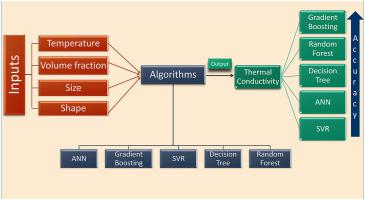Case Studies in Thermal Engineering ( IF 6.4 ) Pub Date : 2021-11-26 , DOI: 10.1016/j.csite.2021.101658 Palash Sharma 1 , K. Ramesh 1 , R. Parameshwaran 1 , Sandip S. Deshmukh 1

|
In this study, the thermal conductivity of titania (TiO2)–water nanofluid was predicted using five separate machine learning algorithms with their unique hyperparameters and logical functions. A detailed comparative study on the TiO2–water nanofluid dataset was performed using the artificial neural network (ANN), gradient boosting regression (GBR), support vector regression (SVR), decision tree regression (DTR), and random forest regression (RFR) algorithms. A complete data intelligence analysis of 228 collected data points on different shape and size of titania (TiO2)–water nanofluid was conducted. The dataset consisted of five parameters including size, shape, volume fraction of the nanoparticles, temperature, and thermal conductivity. The shape of the nanoparticles was considered to be altogether a new parameter for predicting the thermal conductivity of the nanofluids. The mean square error (MSE) and R-square (R2) were used to compare these models. From this comparative study of these algorithms, it was found that the gradient boosting is the best algorithm [R2train = 0.99, R2test = 0.99, MSE.train = 0.0003 and MSE.test = 0.0002] for thermal conductivity predictions with test and train accuracies of 99%. It was observed that, the shape of the nanoparticles could influence the thermal conductivity predictions of the nanofluids, substantially.
中文翻译:

二氧化钛-水纳米流体的热导率预测:使用不同机器学习算法的案例研究
在这项研究中,使用五种独立的机器学习算法及其独特的超参数和逻辑函数来预测二氧化钛 (TiO 2 )-水纳米流体的热导率。使用人工神经网络 (ANN)、梯度提升回归 (GBR)、支持向量回归 (SVR)、决策树回归 (DTR) 和随机森林回归 (RFR)对 TiO 2 -水纳米流体数据集进行了详细的比较研究。) 算法。对不同形状和尺寸的二氧化钛 (TiO 2)-水纳米流体进行。该数据集由五个参数组成,包括纳米颗粒的尺寸、形状、体积分数、温度和热导率。纳米颗粒的形状被认为是预测纳米流体热导率的一个新参数。均方误差 (MSE) 和 R 方 (R 2 ) 用于比较这些模型。通过对这些算法的比较研究,发现梯度提升是最好的算法[R 2 train = 0.99,R 2 test = 0.99,MSE。训练 = 0.0003 和 MSE。测试 = 0.0002] 用于热导率预测,测试和训练准确度为 99%。观察到,纳米颗粒的形状可以显着影响纳米流体的热导率预测。











































 京公网安备 11010802027423号
京公网安备 11010802027423号